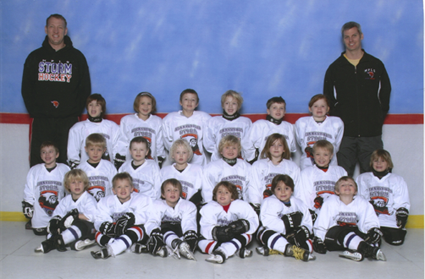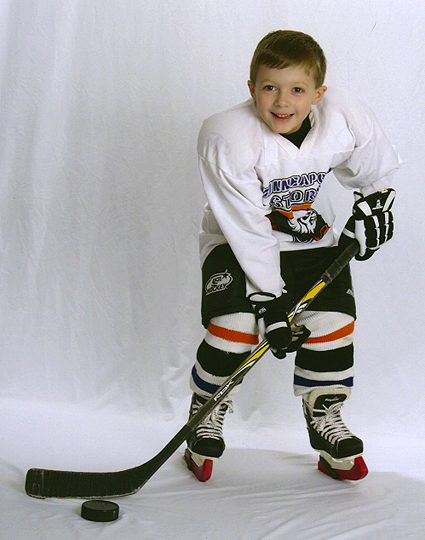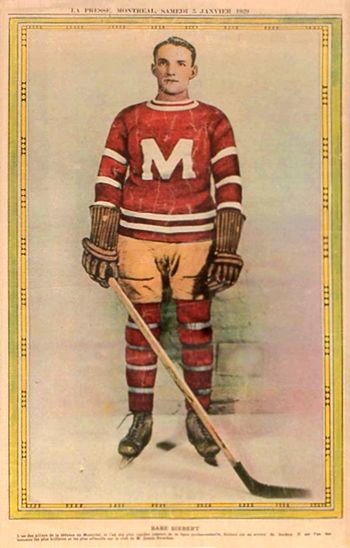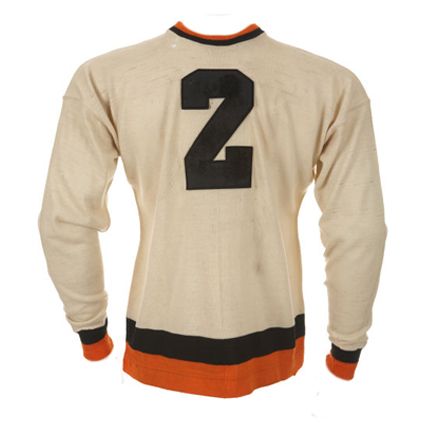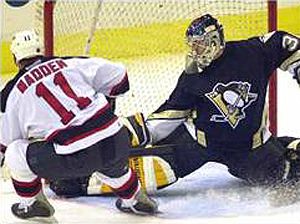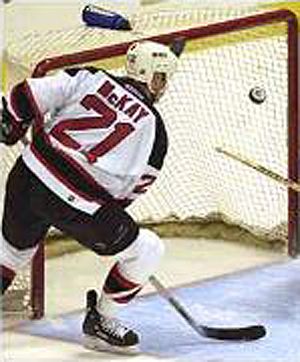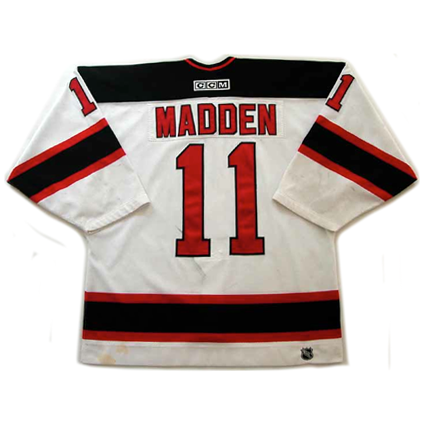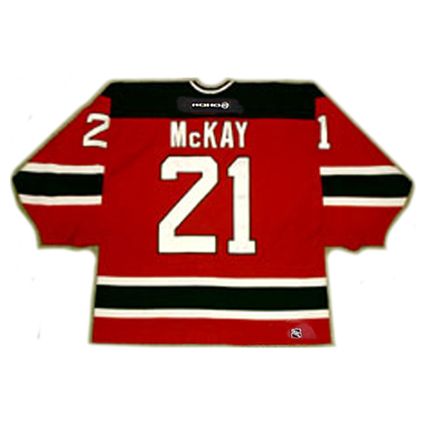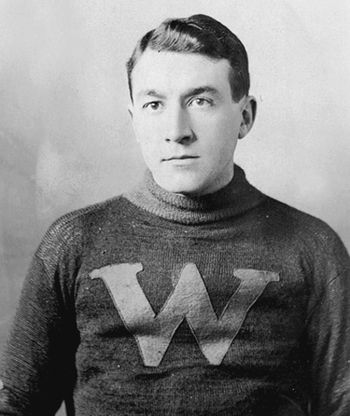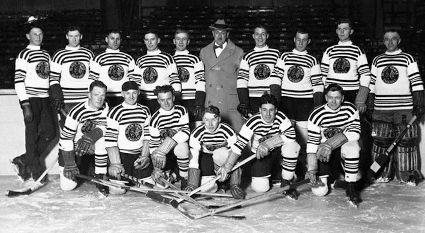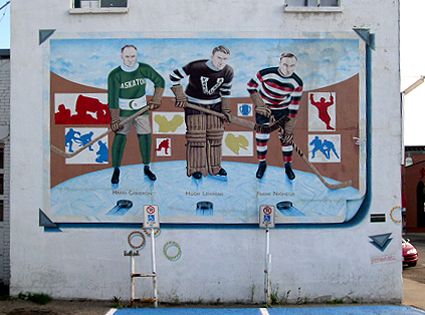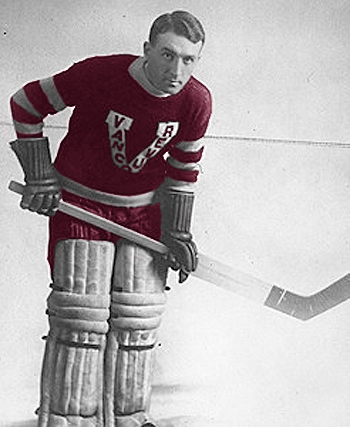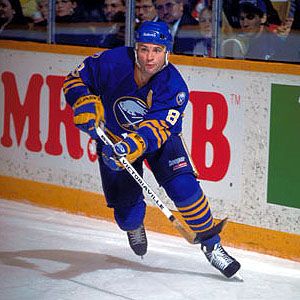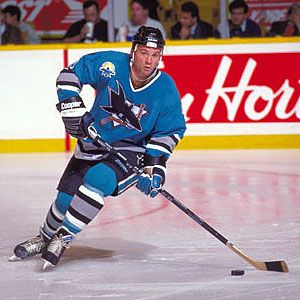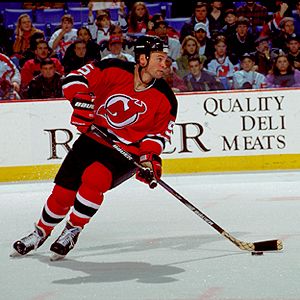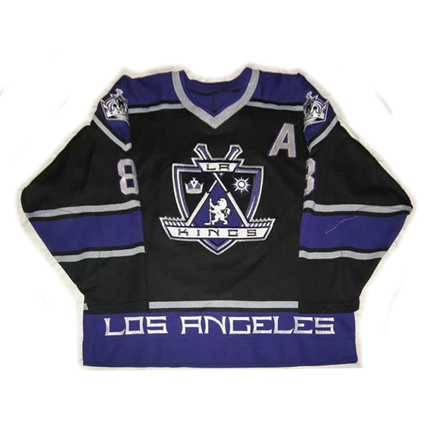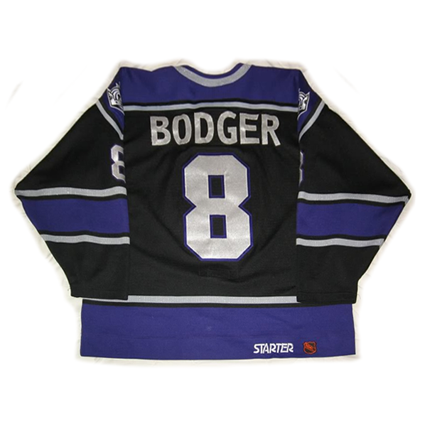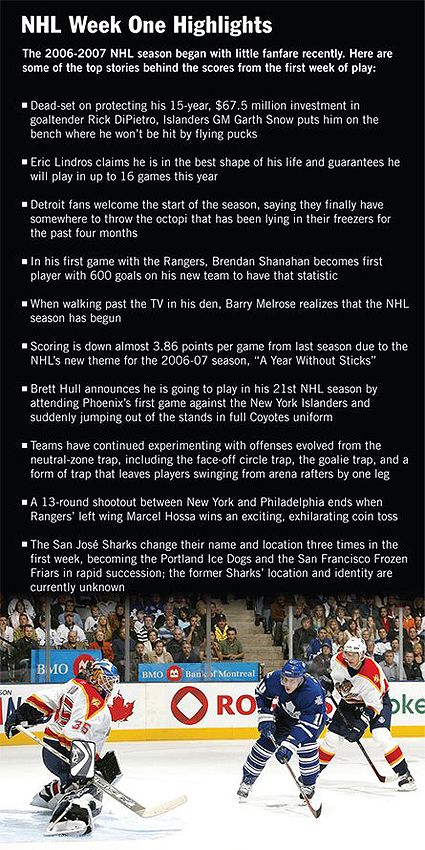Saturday, October 30, 2010
2009-10 Minneapolis Storm Jersey
Youth hockey season kicks off around our household today with "training camp" this weekend, as the 4 through 8 year old players in the Minneapolis youth hockey program are evaluated and divided up into their respective Mighty Mite and Mite levels.
There's nothing more fun that watching a swarm of Mighty Mites (boy and girls ages 4 to 8 with no previous experience), as they first get their legs under them wearing helmets which double the size of their little heads! You can usually count on at least three or four times in any practice session that the last child in line waiting to participate in a drill will suddenly have their feet shoot out from under them at some random moment taking out the feet of the child in front of them, who takes down the child in front of them, who takes down the child in front of them, who takes down the child in front of them until they entire line has done a "reverse-domino" tumble from back to front, bottom to top.
The season begins in early November and runs through February and requires two hours each Saturday, an hour of which is the actual practice and the other hour divided between putting all their gear on beforehand and taking it all off in the crowded arena lobby afterwards!
2009-10 Minneapolis Storm Mighty Mites
One unfortunate aspect of ice hockey is the cost. While a seven year old child can participate in soccer or t-ball at the local park's rec center for $30 for a season, plus the $13 for a baseball glove at Target, the fee for the equivalent level of hockey, Mighty Mites, is an eye-popping $250.
The fees are even more staggering when you move up in age groups, with Mites (Under 8 years old) $450, Squirts (U10) $900, Peewees (U12) $1300 and Bantams (U14) at $1400 for a single season, and that's before you own a single piece of equipment!
Fortunately, children outgrow their gear rather quickly and most anything you require can be purchased second hand at a place like Play it Again Sports, who will give you a store credit for most any useable gear you bring in in season.
Special mention must be given to the now annual equipment drive, sponsored by the Minnesota Wild, Let's Play Hockey Magazine and Minnesota Hockey, where drop off boxes are placed in arenas all over the metro area for people to donate their unwanted hockey equipment, in both youth and adult sizes, which is then distributed for free at the home of the Wild, the Xcel Energy Center, in early October. The first season 750 people were able to obtain over 2,000 pieces of gear and we're certain those totals were soundly beaten this year.
There is also a wonderful equipment rental program which provides a gear bag, hockey pants (or "breezers"), shin guards, elbow pads, the shoulder pad/chest protector and gloves for an outstanding $20 a season or $25 with a helmet. Jerseys and socks are provided for each player, leaving you responsible for perhaps the helmet and the skates, which you can easily obtain used as documented above.
Money is also available for scholarship programs to help cover some of the cost of hockey. Don't be afraid to ask questions about financial assistance to get your child out on the ice. It can offer them years of fun, focus, direction and teach them lessons beyond the skills of playing, such as sportsmanship and leadership.
Not much thrills a kid more than the fun of being a hockey player!
After completing a successful run in Mites, your child will hopefully continue to move up the ladder to Squirts, Peewees and Bantams.
Aside from having fun, youth hockey is a way to make friendships, for both kids and parents, as there are always a gallery of other parents with something in common with you, sitting in a cold arena during some of your rare weekend time off from work!
From there the ladder system continues with High School, Junior and perhaps even college hockey, for both men and women.
Today's featured jersey is a 2009-10 Minneapolis Storm jersey. The jerseys are given out in order, so you never know what non-traditional hockey number your child may end up with...
Here are the Minneapolis Storm "Little Chippers" at Mariucci Arena putting on a show between periods at a University of Minnesota game last season. It's always a great thrill for youth teams to put on a show in front of 10,000 people at Mariucci Arena or 18,000 at the Xcel Energy Center at a Wild game.
Here's a look at the fun a season of Mite hockey can offer you and your child.
Labels:
Minneapolis Storm,
Youth Hockey
Friday, October 29, 2010
1939 NHL All-Star Eddie Shore Jersey
Prior to the NHL All-Star Game being an annual affair, which began with the first annual game in 1947, three previous benefit games took place featuring a team of NHL All-Stars on one side of the contest.
The third and final of those benefit games took place on this date in 1939 in memory of Babe Siebert, a former NHL player who had recently been named head coach of the Montreal Canadiens who drowned in Lake Huron while swimming before he began his new job as coach.
Babe Siebert from his playing days with the Montreal Maroons
To benefit his family, a game was organized by the Montreal Canadiens and Montreal Maroons, both of whom Siebert had played for during his career. Held in the Montreal Forum, 6,000 fans attended the game between the Montreal Canadiens and a team of NHL All-Stars, raising $15,000 for Siebert's family.
Syl Apps, of the Toronto Maple Leafs, scored four points, one goal and three assists, in a 5-2 win for the All-Stars over the defending Stanley Cup champion Canadiens.
"Busher" Jackson and Eddie Shore were named to the All-Star team, the only two players to appear in all three of the benefit era games, as well as Apps, Johnny Gottselig, who had a goal and two assists.
The All-Stars got on the board first with a pair of goals in the first period, first by Bobby Bauer from Apps and Gottselig at 8:30 followed by Shore for the All-Stars at 10:07, also from Apps and Gottselig.
Apps got his goal at 2:05 of the second from Bauer before Montreal got on the board when Earl Robinson scored on an assist from George Mantha and Ray Getliffe at 5:49.
The All-Stars get that one back two minutes later when Gottselig scored at 7:49 from Apps and Art Coultier and widened their lead to 5-1 when Earl Seibert (note the different spelling from Siebert) scored an unassisted goal at 11:21. Louis Trudel closed out the scoring at 19:15 of the second period when he scored on the All-Stars Frank Brimsek from Polly Druin and Rod Lorrain, as there was no scoring in the third period. Wilf Cude took the loss in goal for the Canadiens.
Today's featured jersey is a 1939 NHL All-Star Eddie Shore jersey as worn in the Siebert Memorial Game on this date in 1939. This wool sweater was used just the single time during the All-Star contest and has survived in immaculate condition. Shore left it behind in his locker in New York after retiring while a member of the New York Americans after spending the majority of his career with the Boston Bruins.
Labels:
NHL All-Star Game,
Shore Eddie,
Siebert Babe
Thursday, October 28, 2010
2000-01 New Jersey Devils John Madden Jersey
On this date in 2000, the New Jersey Devils travelled to Pittsburgh to take on the Penguins. It was the Devils 9th game of the season and they brought a 5-2-1 record into the game as well as a three game winning streak. Pittsburgh, meanwhile, stood at 5-3-1 after starting their season with a pair of games in Tokyo, Japan, tied with the Devils with 11 points atop the Atlantic Division.
Martin Brodeur got the start in goal, while Jean-Sebastien Aubin got the nod for Pittsburgh.
Turner Stevenson got the scoring started with with a goal from Sergei Nemchinov and John Madden at 2:02 of the first period to put the Devils up by one.
The same line struck again at 4:45, this time with Madden scoring from Nemchinov and Stevenson. Randy McKay put the Devils up by three when he scored on the power play at 12:32 from Bobby Holik and Colin White at 11:18. Before the period ended, McKay scored his second off a goal post from Ken Sutton and Holik at 19:30 to send the Devils into the locker room with a stout 4-0 lead.
The second period began with Garth Snow taking over in goal for Pittsburgh and he held the Devils off the scoreboard for half a period until Madden scored his second at 11:10 on Nemchinov's third assist. The rout was on when McKay completed his hat trick at 12:32 from Brian Rafalski. It was the third hat trick of his career.
Five minutes would pass before McKay scored his fourth of the night on a rebound off the back boards on a shot from Patrik Elias with the second assist from Rafalski at 17:44 before Madden made good in his bid for his first career hat trick with assists from Stevenson and Sutton at 18:57, putting the Devils out of reach at the end of 40 minutes 8-0.
Clearly owning the hot hand, their teammates kept feeding McKay and Madden the puck in the third period and Madden converted from a bad angle with assists from Ed Ward and Jim McKenzie for his fourth goal of the night at 15:55 of the third period to tie New Jersey's largest margin of victory ever at 9, accomplished twice before.
When Madden scored his fourth goal, he and McKay became the first teammates to score four goals in a game since Odie and Sprague Cleghorn did it for the Montreal Canadiens way back on January 14, 1922, a gap of over 78 years.
Their four goals in a game also tied a team record held by Pat Verbeek since February 28, 1988.
Lost in the offensive fireworks was Broduer's shutout on 21 saves and McKay nearly stole the spotlight from Madden when he hit the pipe in the third period, just missing his fifth goal of the night.
McKay was named as The First Star of the Game despite Madden having five points in the game. "Randy's goals were much more fashionable than mine, so I'm sure they gave it to him for that even though I had one more point than he did." Madden needled after the game.
"I was in the right spot in the right time tonight, and it seemed like every time I got in the open, someone got me the puck," McKay said. "It was one of those nights where every time I touched the puck, I felt I had a shot. The last one, it came back to me, flat as could be, right in my wheelhouse and I had an open net to shoot at. Every time I came back to the bench, Bobby Holik was shaking his head. He couldn't believe it."
Holik concurred, "That's because he didn't just get goals, he got pretty goals, three of them. I was like, 'whooooo'. They weren't just going in, the goalie had no chance on them. It was hard to believe."
The reason for the extra celebration and incredulous reaction was that McKay was not known as much of a goal scorer and generally was a member of the Devils "Crash Line" of checkers and grinders. In his nine previous season in New Jersey, he averaged 12 goals a season with a career high of 24. After his four goal outburst, McKay would score just 16 goals in the Devils 73 remaining games.
"I scored one, I was happy with one," Madden Said. "The puck was coming my way."
"I would like to say I'm sorry to the people who bought tickets," Penguins coach Ivan Hlinka said. "I would like to say thanks to the people who stayed to the finish. I believe we ware not a bad team like tonight. I hope we will show our face over the next game and the next week."
Penguins defenseman Bob Boughner went farther, saying, "Maybe we should all take money out of our next checks and pay all the fans who stayed to watch the rest of that game. It's a joke."
This game was played back in the era when the home team traditionally wore white jerseys, but with the increasing number of colored alternate jerseys now in use, the visiting teams often had to wear white on the road to accommodate the home teams wearing their third jerseys, as was the case in the game where Madden and McKay each scored four goals, as Pittsburgh had just reintroduced the skating penguin logo on their new alternate jerseys in 2000-01.
In order to eliminate the need for the road teams equipment managers to have to pack two sets of jerseys for road trips, the rule was changed for the 2003-04 season onwards, where the road team would nearly always wear white, regardless of the home team was wearing their dark home jersey or colored alternates. There are of course always exceptions to this rule, but in general it made life easier for the traveling equipment managers league wide.
Today's Bonus jersey is a 2000-01 New Jersey Devils Randy McKay jersey. The Devils jersey is on it's way to joining the Canadiens, Red Wings and Blackhawks as one of the longest tenured iconic jerseys in the NHL, as team president Lou Lamoriello steadfastly remains against any changes to the Devils jersey adopted in 1992, including the adoption of an alternate jersey for the Devils.
Today's video segment begins with a Randy McKay overtime game winner in the 1995 playoffs, in what was until then a scoreless tie against the Boston Bruins.
In this next clip, Madden fires one in off the post to electrify the crowd.
Labels:
Madden John,
McKay Randy,
New Jersey Devils
Wednesday, October 27, 2010
1914-15 Vancouver Millionaires Hugh Lehman Jersey
One of hockey's early pioneers, Hughie Lehman was born on this date in 1885.
Bonus jersey: Today's Bonus jersey is a 2008-09 Vancouver Giants throwback 1915 Vancouver Millionaires jersey as worn on November 21, 2008 when the Giants held a "Stanley Cup Legends Night". The Millionaires won their only Stanley Cup in 1915 wearing the original version of this jersey.
Lehman, a goaltender, began his hockey career with the Pembroke Lumber Kings of the Ottawa Valley Hockey League in 1903. He played in Pembroke for three seasons, including posting an 8-0 record in 1905-06. He was known as a strong skater and good puck handler.
In 1906-07, Lehman moved to the Canadian Soo of the International Professional Hockey League for one season before returning to Pembroke in 1907-08. He joined the Berlin Professionals of the Ontario Professional Hockey League in 1908-09.
The next season was a busy one for Lehman, as he played for the Galt Professionals in two games during their challenge for the Stanley Cup against the the dominant Ottawa Senators. He played the regular season with Berlin (now known as Kitchener), which resulted in a second Stanley Cup Challenge in just two months, this time against the current cup holders the Montreal Wanderers. His puck handling skills even including scoring a goal once while playing in Berlin, something that would not happen in the NHL for another 70 years!
Following the 1910-11 season, Lehman packed his bags and moved west in order to play for the New Westminster Royals of the new Pacific Coast Hockey Association.
It proved to be a good move for him, as the Royals won the championship in their first season. After two more seasons with New Westminster the club folded and Lehman found a home in Vancouver with the Millionaires.
Hugh Lehman wearing the W of New Westminster
It proved to be a good move for him, as the Royals won the championship in their first season. After two more seasons with New Westminster the club folded and Lehman found a home in Vancouver with the Millionaires.
While up to this point in his career Lehman had not put together a remarkable season since his 8-0 season in 1906, the Millionares stormed the PCHA with Lehman playing every game on his way to a 13-4 record. As champions of the PCHA, the Millionaires earned the right to host the NHA Champion Ottawa Senators, who they swept three games to none, earning Lehman the Stanley Cup.
The 1915 Stanley Cup Champion Vancouver Millionaires
He would play seven more seasons with the Millionaires, winning two more PCHA titles in 1918, 1921 and 1922, but the Millionaires would fall short in their quest for another Stanley Cup.
Lehman would continue to play for Vancouver over the course of the next four seasons, but the club were now known as the Vancouver Maroons. Two of the four seasons were as part of the PCHA, where the Maroons were league champions, including the 1922-23 season in which he went 16-8-1. In his 13 PCHA seasons, Lehman was named an All-Star ten times.
The Maroons joined the Western Canada Hockey League in 1924-25, which was shortened to the Western Hockey League for 1925-26.
When the WHL collapsed, Lehman joined the expansion Chicago Black Hawks of the National Hockey League for their first ever season. At the age of 41, he played 44 games that year, 14 more than he ever had previously, and finished with 19 wins, a career high, 22 losses and 3 ties.
The 1926-27 Chicago Black Hawks
The following season he had played in four games when Black Hawks owner and manager Frederic McLaughlin drew up some plays for the team. Lehman reacted by calling it "the craziest bunch of junk I've ever seen." When Lehman was called to McLaughlin's office afterwards, he was expecting the worst. It would turn out that Lehman had played in his final game, as McLaughlin appointed him as the Black Hawks new head coach!
Lehman was was inducted into the Hockey Hall of Fame in 1958.
Lehman is memorialized in a mural in his home town of Pembroke, along with fellow Hall of Famers and Pembroke natives Harry Cameron (left)
and Frank Nighbor (right)
Today's featured jersey is a 1914-15 Vancouver Millionaires Hugh Lehman jersey. No original Millionaires jerseys are known to exist and most Millionaires memorabilia was lost when their home rink, the Denman Arena, burned down in 1936.
Today's featured video is a departure from the norm, a music video featuring photos and archival footage of the Vancouver Millionaires as part of a music video for a song entitled "The Vancouver Millionaires".
Our next video is a report of the Canadian junior team the Vancouver Giants wearing throwback 1915 Millionaires jerseys, including cream colored hockey pants. Good stuff!
Finally a news report about a Vancouver Millionaires replica jersey being donated to the British Columbia Sports Hall of Fame.
Labels:
Lehman Hughie,
Vancouver Millionaires
Tuesday, October 26, 2010
1995-96 Pittsburgh Penguins Mario Lemieux Jersey
Mario Lemieux debuted for the Pittsburgh Penguins in 1984 at a time when the Penguins were playing to an arena that was half empty and subject to rumors of relocation.
He scored a goal on his very first shot in his very first game, and the Penguins were on the road to recovery. Lemeiux would go on to win the Calder Trophy that season and place second in the scoring race, while winning the Pearson Award in his second year.
His game reached the next level with his performance in the 1987 Canada Cup, when at age 21, he was able to play with veterans Wayne Gretzky, Mark Messier and Paul Coffey. That experience launched his game to the next level and he won his first Art Ross Trophy in 1987-88 with 168 points, ending Gretzky's seven year hold on the league scoring title, as well as the Hart Trophy.
The following season was the greatest of his career, when he scored a career highs with 85 goals and 114 assists for 199 points and his second scoring title.
Eventually, the toll on his body began to affect him and in 1990 he had to undergo back surgery for a herniated disc, which caused him to miss 50 games of the following season. He would return to lead the Penguins over the Minnesota North Stars to the Stanley Cup Championship and win the Conn Smythe Trophy as playoff MVP.
The following season he was limited to 64 games due to injuries, yet still won his third scoring title. Although a slash broke his left hand, which caused him to miss five games, Lemieux still led the playoffs in scoring and won his second Conn Smythe Trophy as the Penguins won their second consecutive Stanley Cup.
In January of the following 1992-93 season, Lemeiux was diagnosed with Hodgkin's Lymphoma and had to undergo radiation treatments to combat the disease, which caused him to miss two months of the season. On the last day of his radiation treatments, he flew to Philadelphia and famously scored a goal that evening after receiving a standing ovation from the notoriously hostile Philadelphia fans. He continued to score at a furious pace and won his fourth scoring title later that season with a remarkable 160 points in just 60 games. His remarkable return from cancer would be recognized with the awarding of that season's Masterton Trophy.
More back surgery awaited him in the off season, which would cause him to miss the first 10 games of the season as well as 48 more later in the year with more back problems. The combined effects of his back problems and fatigue from the radiation treatments caused Lemieux to announce he was taking the 1994-95 season off after making it into just 22 games that season.
He returned to the game of hockey for the start of the 1995-96 season after a 17-month layoff, and in his seventh game back on this date in 1995, Lemeiux would score his 500th NHL goal in just his 605th game, second only to Gretkzy's 575. He would finish the season with 69 goals and 92 assists for 161 points and his fifth scoring title as well as being named the winner of his third Hart Trophy.
Today's featured jersey is a 1995-96 Pittsburgh Penguins Mario Lemeiux jersey as worn when Lemieux scored his 500th NHL goal, becoming only the 20th player in league history to reach that important milestone.
This jersey style was worn beginning in the 1992-93 season and was inspired by the original Penguins jerseys of 1967-68 which also featured the diagonal "Pittsburgh" cresting on the front and is one of our personal favorites here at ThirdStringGoalie with it's mix of modern styling with a classic influence. They would remain in use through the 1996-97 season until being replaced by then then alternate jersey for the following season.
Today's video section is Lemeiux scoring his 500th NHL goal against the New York Islanders on this date in 1995.
Labels:
Lemieux,
Pittsburgh Penguins
Monday, October 25, 2010
1998-99 Los Angeles Kings Doug Bodger Jersey
Doug Bodger played his junior hockey with the Kamloops Junior Oilers in the Western Hockey League. There, the defenseman caught the eye of the Pittsburgh Penguins after scoring 21 goals and 98 points from the blueline in 1983-84, prompting the Penguins to draft him 9th overall in the 1984 NHL Entry Draft.
He joined the Penguins later that year and played for Pittsburgh four seasons in which he averaged 40 points per season including a career high 14 goals in 1987-88. Early in the 1988-89 season, Bodger was traded to the Buffalo Sabres as part of a deal which brought goaltender Tom Barasso to the Penguins.
While with Pittsburgh, Bodger was chosen to play for Canada at the 1987 World Championships, the first time he would play for his country.
While the Penguins were in a down period while Bodger was with Pittsburgh, never qualifying for the playoffs, the season he joined the Sabres they made the playoffs for the first of seven consecutive seasons, including the 1992-93 season in which he set a career high with 54 points. Bodger proved to be a very reliable player while in Buffalo, regularly playing 70 games or more.
Bodger was then traded to the San Jose Sharks early in the 1995-96 campaign for two players and a pair of draft picks. While in San Jose, he added a veteran presence to the young Sharks blueline.
Following the season, Bodger completed for Canada at the World Championships once more, this time earning a silver medal.
He would again rack up the games the following season with the Sharks, appearing in 81 contests. After 28 games of the 1997-98 season, Bodger was dealt across the continent to the New Jersey Devils for the last 49 games of the schedule, followed by his first playoff appearance since 1995 with Buffalo.
The Devils then traded Bodger, sending him all the way back to California, this time with the Los Angeles Kings for the 1998-99 season, which would include his 1,000th NHL game on this date in 1998, a 3-2 win for the Kings over the Carolina Hurricanes. He would complete his season by making his third appearance for Canada at the World Championships in 1999.
For the 1999-00 season, Bodger signed with the Vancouver Canucks as a free agent, but would play just 13 games for the Canucks prior to retiring on December 14th of that season.
His final NHL stats are 1,071 games played, 106 goals and 422 assists for 528 points. He would also play in 47 playoff games, scoring 6 goals and 24 points.
In 2006, he was inducted into the British Columbia Hockey Hall of Fame after being the highest scoring defenseman from British Columbia.
Today's featured jersey is a 1998-99 Los Angeles Kings Doug Bodger jersey. This was the first year for this style Kings jersey and the only season it was made by Starter. This style replaced the black and silver "Gretzky era" jerseys.
One issue we had with this style jersey was the small details of the main coat of arms crest being too fine when viewed at any sort of a distance. Someone apparently agreed with us, as the Kings flipped the coat of arms crest on their home and road jersey with the bolder crown logo used on their purple alternate jersey for the 2002-03 season.
For collectors, this relatively unique situation means you must pay attention to details, as all three colors of Kings jerseys, the black, white and purple, have all been made in both the coat of arms and crown logo versions at different times.
Here's an easy way to get an assist, pass the puck to Mario Lemieux and let him do the rest.
Hallelujah, Hollywood, Bodger scores for the Penguins in 1986, with an assist to the flashy Ron Duguay.
Here is Bodger's second goal of the same game as above.
Labels:
Bodger Doug,
Los Angeles Kings
Sunday, October 24, 2010
Subscribe to:
Comments (Atom)

